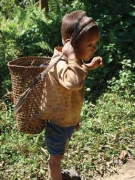 This study by IWMI maps the household water poverty in a typical remote village of the northeast, understands the causes for such a scenario and reflects on the past efforts. Local water resource-based multiple-use water systems that provide water supply both for household and livestock needs and for small high-value agriculture are understood.
This study by IWMI maps the household water poverty in a typical remote village of the northeast, understands the causes for such a scenario and reflects on the past efforts. Local water resource-based multiple-use water systems that provide water supply both for household and livestock needs and for small high-value agriculture are understood.
The per capita and per hectare availability of water in India is highest in this region but the societal (both productive and consumptive) water use is less than five per cent of the existing potential. The unutilised and excessive water supplies during the rainy season create a mayhem of devastations almost every year with ravaging floods, landslides, soil erosion and other infrastructural failures and miseries and unrest in large parts.
Extreme water scarcity during the post-rainy season seriously constrains the farmers’ access to a reliable water source and to a meaningful economic activity at the farm and extreme hardships for the household. This aptly presents a ‘water poverty’ scenario in an otherwise ‘water-abundant’ region.
Several of the farm-level water management innovations and traditional practices methods tried out in the region have found favor at local and/ or policy level and included into the development programs for the region. It looks certain that a more appropriate water supply and distribution system should satisfy most of the following criterion:
- The system should meet both the domestic (including livestock) and small irrigation water needs for high value agriculture.
- It should be flexible, to switch over from domestic to productive use and vice-versa as per the seasonal demands.
- The system should be capable of integration with low-cost and water saving precision application methods.
- The systems should be simple and low cost and maintenance costs should be small.
- Above all, the water supply, distribution and use must ensure community participation and acceptance and be gender-sensitive.
The report presents the benefits, technique, components and experiences of implementation of a number of Multiple-Use Water Systems (MUS) in the Nepal hills. Finally, conclusions and recommendations are provided for out-scaling of the MUS to the northeast hill region for ensuring water and livelihood security at the household and community level.